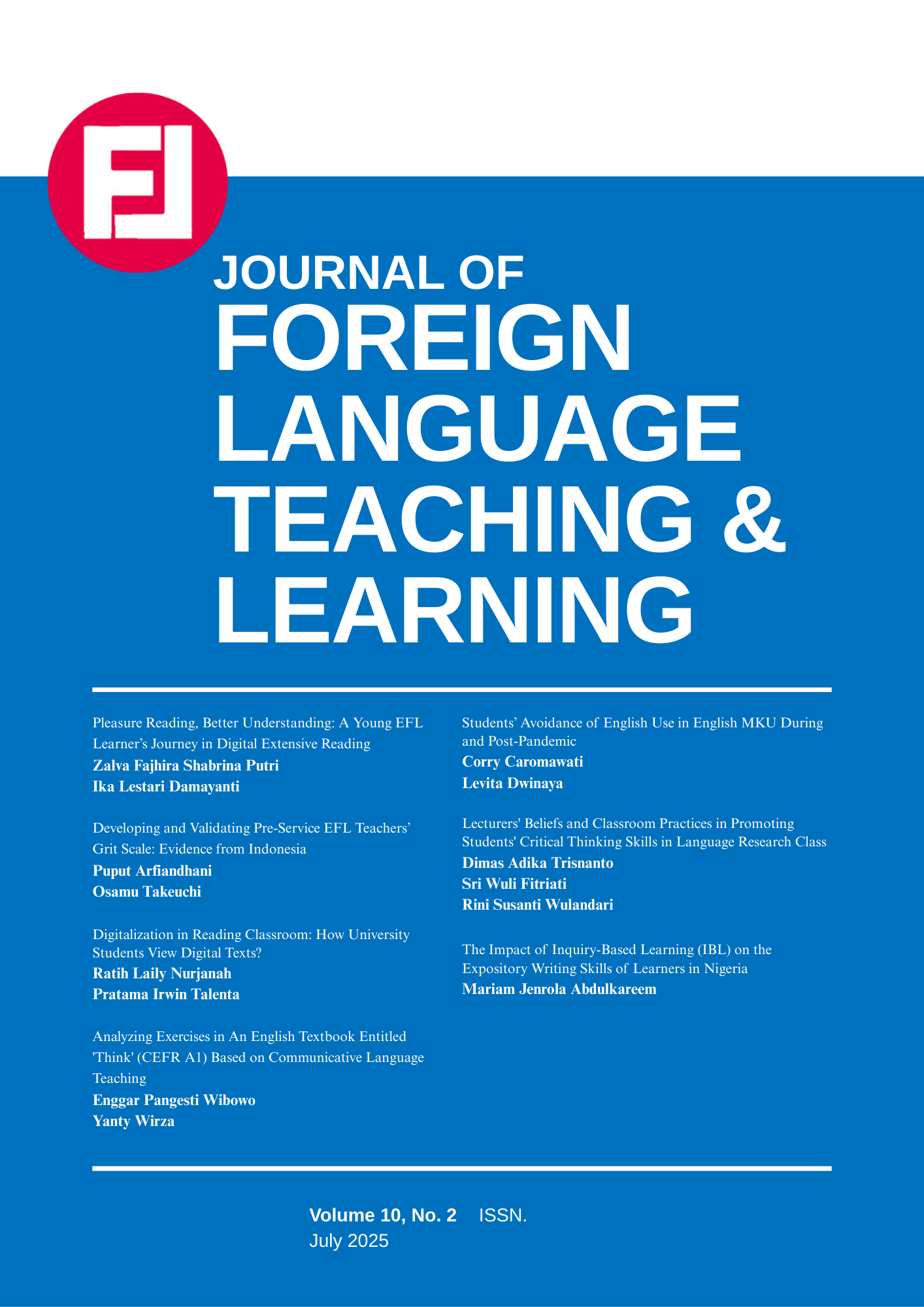Digitalization in Reading Classroom: How University Students View Digital Texts?
DOI:
https://doi.org/10.18196/ftl.v10i2.26814Keywords:
digital text, ELT, extensive reading, ICT in classroom, reading comprehensionAbstract
Background: The implementation of digital texts in classrooms can be helpful yet coming with some issues faced by the students. The research gap targeted by this paper is related to how students view digital texts in terms of the implementation and how digital texts influence their reading comprehension.
Objective: This paper aims to present how students perceived the use of digital text in a reading classroom.
Methods: It was a case study involving 40 students of 4th semester as the respondents selected with purposive sampling technique to fill out a questionnaire distributed by the lecturer. 20 students of them were selected with snowball sampling as the respondents of interview. The responses were analyzed with thematic analysis approach.
Findings: The findings revealed that using digital texts mostly can be enjoyable for students since it is easy for them to bring the text in their smartphones though it comes with several problems such as eyes fatigue. It also revealed that students’ comprehension skill was not significantly helped by digital texts.
Conclusion: The implication is presenting insights on how to manage the use of digital texts based on students’ perceptions.
References
Ayşegül, L. K., & Karadeniz, S. (2021). Children’s Reading Comprehension and Motivation on Screen Versus on Paper. SAGE Open, 11(1). https://doi.org/10.1177/2158244020988849
Fitriyah, I. (2022). Understanding efl students’ reading motivation and online reading practice in relation to their reading achievement in a full online learning context. Proceedings of the Fifth International Conference on Language, Literature, Culture, and Education (ICOLLITE 2021), 595(Icollite), 351–356. https://doi.org/10.2991/assehr.k.211119.054
Fusch, P., Fusch, G. E., & Ness, L. R. (2018). Denzin’s paradigm shift: Revisiting triangulation in qualitative research. Journal of Social Change, 10(1), 19–32. https://doi.org/10.5590/josc.2018.10.1.02
Hargreaves, H., Robin, S., & Caldwell, E. (2022). Student perceptions of reading digital texts for university study. Journal of Learning Development on Higher Education, 24(24).
Indrayadi, T. (2021). Indonesian efl learners’ reading motivation. IJELTAL (Indonesian Journal of English Language Teaching and Applied Linguistics), 5(2), 335. https://doi.org/10.21093/ijeltal.v5i2.745
Islami, J. D., & Warni, S. (2020). EFL Students’ Perceptions of Reading Electronic Books. Journal of ELT Research, 5(1), 37–52. https://doi.org/10.22236/JER
Kaman, S., & Ertem, I. S. (2018). The effect of digital texts on primary students’ comprehension, fluency, and attitude. Eurasian Journal of Educational Research, 76(1), 147–164. https://doi.org/10.14689/ejer.2018.76.8
Lim, F. V., & Toh, W. (2020). How to teach digital reading? Journal of Information Literacy, 14(2), 24–43. https://doi.org/10.11645/14.2.2701
Liu, Z. (2005). Reading behavior in the digital environment: Changes in reading behavior over the past ten years. Journal of Documentation, 61(6), 700–712. https://doi.org/10.1108/00220410510632040
Liu, Z. (2012). Digital reading: An overview. Chinese Journal of Library and Information Science, 5(January), 85–94. http://scholarworks.sjsu.edu/cgi/viewcontent.cgi?article=1067&context=slis_pub%5Cnhttp://www.chinalibraries.net/
Loh, C. E., & Sun, B. (2019). I’d still prefer to read the hard copy. Journal of Adolescent and Adult Literacy, 62, 663–672.
Long, D., & Szabo, S. (2016). E-readers and the effects on students’ reading motivation, attitude and comprehension during guided reading. Cogent Education, 3(1). https://doi.org/10.1080/2331186X.2016.1197818
Mardiah, R., Melati, M., & Safitri, N. T. (2021). Academic purposes digital reading. Proceedings of the Fifth International Conference on Language, Literature, Culture, and Education (ICOLLITE), 595(1), 562–567.
Mortazavi, M., & Davarpanah, A. (2021). Implementation of a thematic analysis method to develop a qualitative model on the authentic foreign language learning perspective: A case study in the university of Northern Cyprus. Education Sciences, 11(544), 1–10. https://doi.org/10.3390/educsci11090544
Ni’mah, D., & Umamah, A. (2020). Mobile-assisted on extensive reading: students’ voices. English Education : Journal of English Teaching and Research, 5(1), 41–48. https://doi.org/10.29407/jetar.v5i1.14367
Phillips, E. (2013). A case study of questioning for reading comprehension during guided reading. Education 3-13, 41(1), 110–120. https://doi.org/10.1080/03004279.2012.710106
Präkel, D. (2021). The impact of digital text. In Script Effects as the Hidden Drive of the Mind, Cognition, and Culture, (pp. 188–189). https://doi.org/10.4324/9781003103943-59
Saqr, A. K. (2021). The effect of digital reading on efl learners’ reading comprehension. International Journal of Education, Technology and Science, 1(1), 59–70. https://doi.org/10.25073/2525-2445/vnufs.4214
Schwabe, A., Lind, F., Kosch, L., & Boomgaarden, H. G. (2022). No Negative Effects of Reading on Screen on Comprehension of Narrative Texts Compared to Print : A Meta-analysis No Negative Effects of Reading on Screen on Comprehension of. Media Psychology, 00(00), 1–18. https://doi.org/10.1080/15213269.2022.2070216
Shaheen, M., Pradhan, S., & Ranajee. (2019). Sampling in Qualitative Research. In Qualitative Techniques for Workplace Data Analysis (Issue January, pp. 25–51). https://doi.org/10.4018/978-1-5225-5366-3.ch002
Sidabutar, M., Sayed, B. T., Ismail, S. M., Quispe, J. T., Vicente, J. S., Wekke, I. S., Shanan, A. J., & Nourabadi, S. (2022). Reading digital texts vs . reading printed texts : Which one is more effective in iranian efl context ? Education Research International, 2022.
Singer, L. M., & Alexander, P. A. (2017). Reading across mediums: effects of reading digital and print texts on comprehension and calibration. Journal of Experimental Education, 85(1), 155–172. https://doi.org/10.1080/00220973.2016.1143794
Srirahayu, D. P., & Premananto, G. C. (2020). The printed book and electronic book (ebook) experiences of digital natives in indonesia. Journal Of Southwest Jiaotong University, 55(6).
Tanjung, F. Z., & Gultom, U. A. (2017). Reading habits in digital era: A research on the students in borneo university. Language and Language Teaching Journal (LLT), 20(2), 147–157.
Taylor, A. K. (2011). Students learn equally well from digital as from paperbound texts. Teaching of Psychology, 38(4), 278–281. https://doi.org/10.1177/0098628311421330
Yaghi, E. T., Abdullah, A., & Mustafa, Z. (2019). Investigation on Motivation of Online Reading : A Case Study Preparatory Year Students. The Turkish Online Journal of Educational Technology, 18(2), 40–51.
Yin, R. K. (2014). Case study research and applications: Design and methods (6th ed.). SAGE PUBLICATION. https://doi.org/10.1177/109634809702100108
Downloads
Published
How to Cite
Issue
Section
License
Copyright (c) 2025 Ratih Laily Nurjanah, Pratama Irwin Talenta

This work is licensed under a Creative Commons Attribution-ShareAlike 4.0 International License.
Copyright
Authors retain copyright and grant the journal right of first publication with the work simultaneously licensed under a Creative Commons Attribution-ShareAlike 4.0 International License that allows others to share the work with an acknowledgment of initial publication in this journal.
Authors are permitted and encouraged to post their work online (e.g., in institutional repositories, social media account, or on their website) after the article getting published in the journal, as it can lead to productive exchanges and earlier and greater citation of published work (See The Effect of Open Access).License
You are free to:
- Share — copy and redistribute the material in any medium or format
- Adapt — remix, transform, and build upon the material for any purpose, even commercially.
Attribution — You must give appropriate credit, provide a link to the license, and indicate if changes were made. You may do so in any reasonable manner, but not in any way that suggests the licensor endorses you or your use.
ShareAlike — If you remix, transform, or build upon the material, you must distribute your contributions under the same license as the original.
- No additional restrictions — You may not apply legal terms or technological measures that legally restrict others from doing anything the license permits.



.png)





